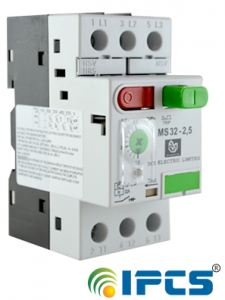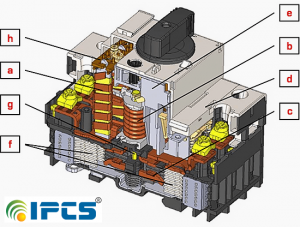
Motor Protection Circuit Breaker or MPCB
Motor protection circuit breakers are a specialized type of electrical protection device that is designed specifically for electric motors, like their name implies.
Electric motors are expensive equipment, so the role of the motor protection circuit breaker is very important. If a motor is not protected correctly, it may be necessary to carry out costly repair works or even replace the equipment completely. Electric motors have plenty of applications, so it is very important to protect them adequately. An electric motor that is adequately protected with an MPCB will have a much longer service life.

In all the industrial and commercial applications of electric motors, the MPCB has the key role of providing electrical protection.
A motor protection circuit breaker, or MPCB, is a specialized electromechanical device that can be used with motor circuits of both 60 Hz and 50 Hz. It has several functions that allow it to provide a safe electrical supply for motors:
Motor Protection Circuit Breaker Working Principle
The motor protection circuit breaker can be considered a sub type of a thermal magnetic circuit breaker, but with additional functions that are specially designed to protect electric motors. The basic working principle is similar to all other circuit breakers.
Thermal protection is used to guard the electric motor against overload. It is based on an expanding and contracting contact that disconnects the motor if excessive current is detected. It is very important to know that thermal protection has a delayed response, to allow the high inrush currents when a motor starts.
However, if the motor is unable to start for some reason, thermal protection will trip in response to the extended inrush current.Magnetic protection is used when there is a short circuit, line fault, or other high current electric fault. Unlike thermal protection, magnetic protection is instantaneous; to immediately disconnect the dangerous fault currents.
The main difference between the MPCB and other circuit breakers is that the MPCB can provide protection against phase unbalance and phase loss. Three-phase circuit motors require three live conductors with balanced voltages in order to operate effectively. An unbalance of more than 2% will be detrimental to the motor’s service life. If one of the phase voltages is suddenly lost, the effect is even more damaging because the motor will keep on running with only two phases.
The motor protection circuit breaker is capable of detecting these conditions by measuring the differences among phase voltages, and disconnects the motor immediately when they occur. It is important to note that phase current unbalance is normal in three-phase systems that power separate single-phase loads, but is unacceptable when the three-phase circuit powers an electric motor.
MPCBs are also equipped with a manual interruption mechanism, allowing disconnection of electric motors for replacement or maintenance.
Motor protection circuit breakers are available in a wide variety of current ratings, and one of their best features is that many models allow the current rating to be adjusted. This means that the same MCPB can be configured to protect motors of different capacities.
Asynchronous Motor Protection.
Most motors used in the industry are asynchronous motors, also known as a squirrel-cage induction motors. These motors use three-phase power to create a rotating magnetic field, which in turn magnetizes the rotor an creates rotational movement. When designing the electrical protection for an asynchronous motor and selecting motor protection circuit breakers, there are some very important factors to consider that aren’t present when protecting other types of electrical circuits.
Asynchronous motors draw a very high inrush current during startup, because they must establish a rotating magnetic field. This current can reach values of 500% to 800% of the rated value for a few fractions of a second. For this reason, the MPCB magnetic protection trips at values greater than 10 times the rated current, unlike some types of miniature circuit breakers which trip at values as low as 3 times rated current. In these cases, using a circuit breaker other than an MPCB will not even allow starting the motor before the magnetic protection trips. In order to reduce the inrush current, a very common practice is to complement the motor protection circuit breaker with a reduced voltage motor starter.
Asynchronous motors require the three phase conductors to have a balanced voltage in order to operate properly. If the phase conductors have an unbalance greater than 2%, the motor will suffer damage over time and will have a reduced service life. The electric motor will also tend to overheat, causing additional energy expenses as waste heat. For this reason, a motor circuit breaker must be able to detect phase imbalance and disconnect the motor accordingly.
If one of the phases is disconnected completely, the motor will keep operating but the current in the remaining two phases will rise above the rated value due to the electrical unbalance, and will probably burn the motor’s winding. For this reason, motor protectors must trip immediately as soon as phase unbalance or phase loss is detected.
This is normally achieved by measuring the differences in current among the phase conductors. If one of the phase currents rises or drops considerably compared with the other two, it is indicative of unbalance. Likewise, if one of the phase currents drops to zero while the other two remain, a phase loss has occurred.
It is very common to complement motor protection circuit breakers with a contactor to allow automatic control of motor startup and disconnection. The system might also include and under-voltage protection device, which disconnects the motor in case the system voltage drops considerably below the rated value
Motor Protection Circuit Breaker parts

a.Thermal over current release
b.Electromagnetic over current release
c.Main contact system
d.Auxiliary switch position
e.Switch latch
f.Arcing chamber (de-ion plates)
g.Plunger armature
h.Differential trip slide
Motor Protection Circuit Breaker Sizing (Selection Guide)
The two main factors that determine the adequate motor protection circuit breaker size are the nameplate voltage and nameplate current, of the motor itself.
The MPCB voltage rating must match the nameplate voltage of the motor. Normally, motor protection circuit breakers can be used in a wide variety of voltage ratings such as 230 V, 380 V, 415 V, 440 V, 500 V, and 660 V AC.
Once the voltage is known, it is necessary to check the nameplate current of the electric motor. It is important to note that the actual operating current may be lower than nameplate current, especially if the motor isn’t fully loaded.
However, the MPCB must always be selected according to nameplate current value in order to allow the inrush current when a motor starts. For example, a motor with a nameplate current of 20 amperes might draw a much lower current during part-load operation, but the MPCB must be selected according to the rated value of 20 amperes, or it might trip if the motor is used at full load.
MPCB manufacturers typically provide charts where the technical specifications of the circuit breaker are presented, in order to simplify the selection process. The current values at which the thermal and magnetic protections operate are displayed in the thermal release and magnetic release columns. Before installing a MPCB, it is very important to verify that voltage and current ratings are compatible with the motor being protected.
Motor protection circuit breakers have a very important role in electrical safety, since the motors they protect have a wide variety of applications in commercial buildings and industry.
It is also possible to complement MPCB with other protection or automation devices such as under-voltage protection, timers, and reduced voltage motor starters.
Adequate selection of the MPCB is key in order to provide reliable motor protection. An undersized MPCB will not even allow the motor to start, while an oversized MPCB might be unable to detect over-current conditions for the electric motor being protected.
